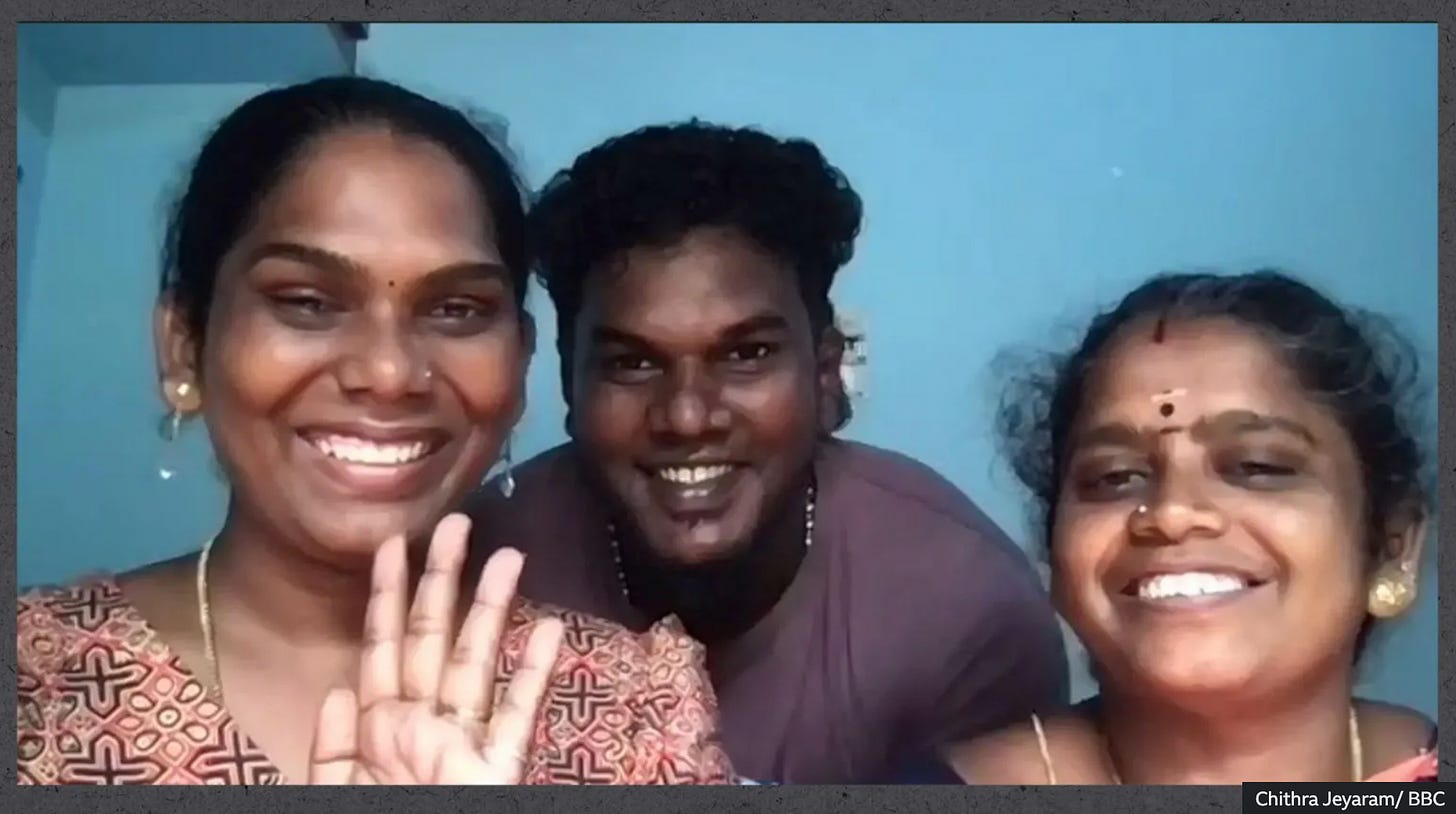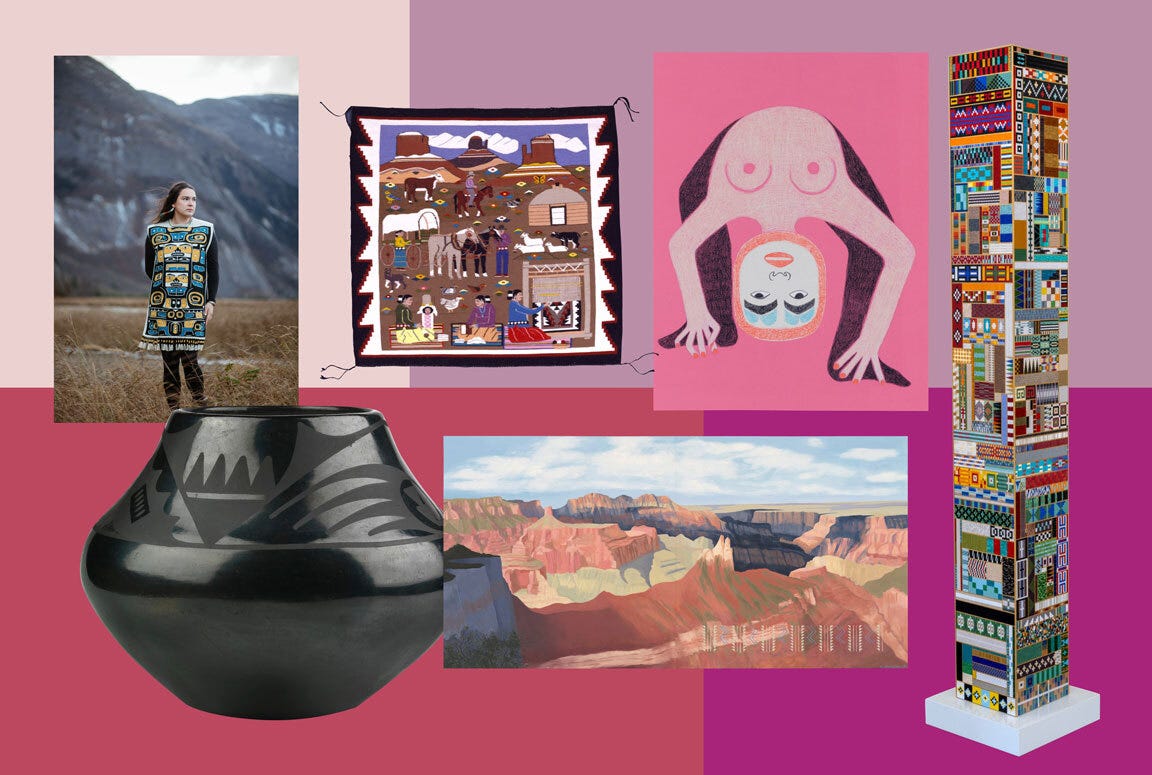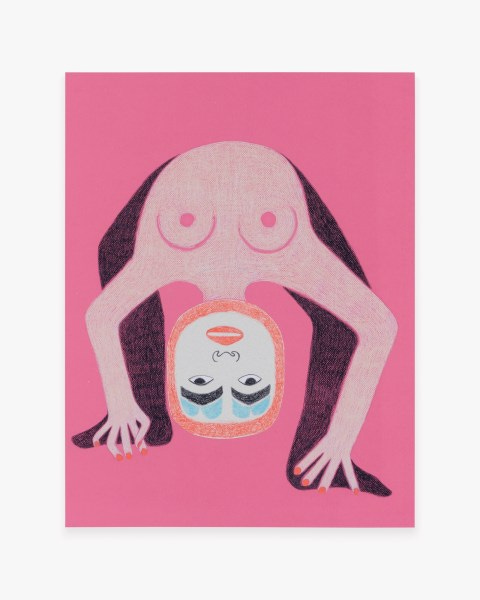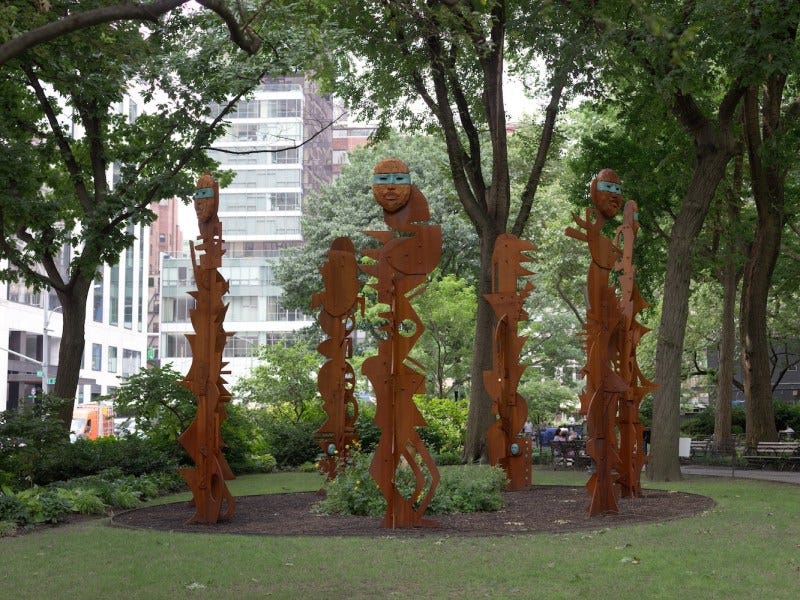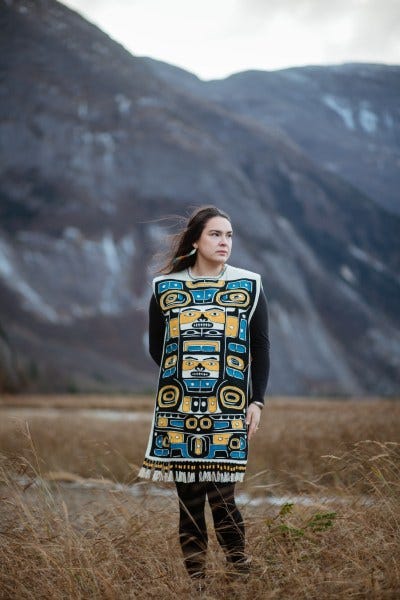Global Roundup: Transgender Day of Visibility Around the World, Gaza Tent Beauty Salon Provides Self-Care, Grannies Football Tournament, Indigenous Women Artists
With the U.S. Capitol in the background, Kali wears a trans equality flag in her hair while attending a rally for the Trans Day of Visibility, on the National Mall, Monday, March 31, 2025, in Washington. (AP Photo/Jacquelyn Martin)
In the U.S., protesters rallied in Washington and New York.
Donald Trump on his first day back in the White House directed the federal government to recognize only two, biologically distinct sexes - male and female - and directed federal agencies to ensure grant funds do not promote "gender ideology."
In India, where same-sex relationships remain largely taboo, hundreds of participants danced to the beats of drums and chanted slogans demanding representation and equal rights.
In 2018, India's Supreme Court decriminalized homosexuality but, in 2023, disappointed the LGBTQ+ community by declining to legalize same-sex marriage, leaving the decision to Parliament.
In Mexico, a sea of transgender flags and banners flowed from the Monument to the Revolution to the Zocalo square, as participants shared their experiences as members of the community.
According to a 2021 survey by Mexico's statistics agency, INEGI, there are some 909,000 people in the transgender, transsexual, or other gender identity population that does not match the sex assigned at birth. That represents 0.9% of people in Mexico aged 15 and over.
Watch a video report from Mexico on Transgender Day of Visibility this year.
Srija, (L) who fought to have her marriage to Arun (C) legally recognised, says everything she's achieved has been made possible by her mother, Valli (R)
"Srija is a gift," Valli, 45, tells the BBC as she and her daughter embrace.
Srija, 25, is from the port city of Thoothukudi.
I know that not all trans people have what I have…My education, my job, my marriage - everything was possible because of my mother's support. -Srija
She and her mother are sharing their story for the first time in Amma's Pride (Mother's Pride), which follows Srija's unique experience.
Srija met her future husband, Arun, at a temple in 2017. After learning they shared mutual friends they soon began texting each other regularly. She was already out as transgender and had begun her transition.
"We talked a lot. She confided in me about her experiences as a trans woman," Arun tells the BBC.
Within months, they fell in love and decided they wanted to spend their lives together.
We wanted legal recognition because we want a normal life like every other couple. We want all the protections that come from a legal recognition of marriage. -Srija
That incudes securities, such as the transfer of money or property if one spouse dies.
In 2014, the Indian Supreme Court established certain protections for transgender people, granting them equal rights to education, employment, healthcare and marriage - although India still does not allow same-sex marriages.
It's not known how many trans couples have married in India, or who was the first. Activists say there was at least one trans wedding legally registered before Srija and Arun's - in 2018 a couple married in Bangalore.
“Of course there are queer couples, or transgender couples, all over India," says the director of Amma's Pride, Shiva Krish, but because of continuing discrimination "several are secretive about their relationship. Srija and Arun, and Valli, are unique in choosing to live their everyday life out in the open."
Srija and Arun's attempt to register their 2018 wedding was rejected, with the registrar arguing that the 1955 Hindu Marriage Act defined marriage as a union between a "bride" and a "groom", which therefore excluded trans women.
But the couple, backed by LGBT activists, pushed back, taking their relationship into the public domain. The effort was worth it.
They received global attention in 2019 when the Madras High Court in Chennai upheld their right to marry, stating that transgender people should be recognised as either a "bride" or "groom" as defined by the 1955 Hindu Marriage Act.
The ruling was seen by LGBT activists as a pivotal step in the acceptance of transgender people in India, with Srija and Arun both becoming well known locally for challenging cultural norms.
But media coverage also invited negative scrutiny.
"The day after local news coverage, I was fired from my job," says Arun, who worked as a manual labourer in the transport sector. He believes it was due to transphobia.
Online trolling followed.
"People sent abusive messages criticising me for being married to a transgender woman," he says.
The couple briefly separated under the strain.
Despite this, Srija excelled at her education, frequently coming first in class at high school.
She went on to complete a degree in English literature from a university in Tamil Nadu, becoming one of the only people in her family to receive higher education.
It's a source of pride for Valli, who left school aged 14.
Even before battling to have her marriage recognised by the state, Srija and her family faced hostility and mistreatment.
After Srija came out as a transgender woman at the age of 17, she and her mother and younger brother, China, were evicted from their home by their landlord.
Several family members stopped speaking to them.
But Srija's mother and brother were steadfast in their support.
I will always stand by my daughter. All trans people should be supported by their family. -Valli
Valli, who became a single parent when her husband died when Srija was just six, works in a kitchen at a school.
But despite earning a modest income, she helped pay for her daughter's gender reassignment, in part by selling some of her jewellery, and cared for her afterwards.
"She takes good care of me," Srija says.
There are thought to be about two million transgender people in India, the world's most populous country, although activists say the number is higher.
While the country has passed trans-inclusive legislation and recognised in law a "third gender", stigma and discrimination remain.
Not a lot of trans people in India, or even the world, have the support of their families. Srija and Valli's story is unique. -Shiva Krish, filmmkaer
Srija says she hopes the film will help challenge stereotypes about trans people and the types of stories that are often promoted in the media about the group - especially those that focus on trauma and abuse.
This documentary shows that we can be leaders. I am a manager, a productive member of the workforce. When people see new kinds of stories on trans people, hopefully their mindsets will also change. -Srija
After premiering at international film festivals, Amma's Pride was shown at a special screening in Chennai, for members of the LGBT community and allies, to mark International Trans Day of Visibility on Monday 31 March.
Following the Chennai screening, a workshop was held where participants in small groups discussed family acceptance and community support for trans individuals.
We hope our screening events will foster connections between trans individuals, their families, and local communities. -Chithra Jeyaram, filmmaker
Noor started working in the field of beauty four years ago, while studying it at a vocational school in Gaza City [Abdelhakim Abu Riash/Al Jazeera]
She set it up in February on a destroyed pavement, the only option available when she and her family returned to the north from their displacement to the south. The salon is a small blue tent with a single table inside topped with a damaged mirror, depilation tools, moisturisers, and some makeup.
Outside the tent in al-Shujaeya east of Gaza City, a white handwritten sign reading: “Noor’s Salon” hangs near the curtained entrance.
Amani Dweima came to the salon with her 16-year-old daughter, Aya.
The 39-year-old wants her eyebrows shaped, and Aya wants a full face of makeup; there’s a wedding planned for that evening.
Since I opened, so many women have come to me with heartbreaking stories … about losing their families and loved ones. They arrive exhausted, their faces drained of light. -Noor al-Ghamari
The idea of a beauty salon in the midst of war may seem odd, Amani and Noor agree, but the act of self-care can help women.
Women come to me from tents, overcrowded schools, or the ruins of their destroyed homes. I try to offer them a moment of comfort, a small escape. My main goal is for them to leave feeling even just a little lighter, a little happier. -Noor al-Ghamari
Amani, who was displaced to Deir el-Balah and has recently returned to the north, as well, didn’t think about going to a beautician at all in the early days of the genocide.
Eventually, she came across a similar salon in Deir el-Balah and started to go as regularly as she could.
Looking after myself changes my mood, especially when I see my reflection in the mirror. I always want to look presentable…The tragedies around us never end. Visiting a beauty salon is … a small escape from all the hardships around us. -Amani Dweima
Back in the north, she was “thrilled” when she saw Noor’s Salon and immediately spread the good news to her neighbours and relatives.
Noor stands in front of her tent salon, on a destroyed street in Shujaeya [Abdelhakim Abu Riash, Al Jazeera]
Noor believes the war has been particularly cruel to women in Gaza – stripping them of their homes and security and of their capacity for self-care as they poured their energy into survival.
I saw many women whose skin was completely burned by the sun from living in tents, constantly cooking over wood fires, washing clothes by hand, and carrying heavy water containers…On top of that, they have no privacy in the overcrowded displacement camps, not to mention the fear, bombings, and all the horrors of war. -Noor al-Ghamari
And yet, she says, she has had clients of all ages who feel that self-care is essential for them.
I met many women who couldn’t stand a single stray hair on their face or eyebrows. Some came to me every week, others regularly or occasionally. -Noor al-Ghamari
She recalls a client she got once, a woman in her early 30s who had been through a huge trauma when her parents and all her siblings were killed in an Israeli air raid.
Coping with her loss meant the woman lost all desire to do anything.
I felt so deeply for her. I gave her a full treatment – threading, eyebrow shaping, a haircut, even a free face massage and masque. When she looked in the mirror, her eyes filled with happy tears. -Noor al-Ghamari
Israel’s war on Gaza began right as Noor was dreaming, laying out the plans for her own – bricks-and-mortar – salon.
Like everyone in Gaza, her life and plans were turned upside down as she, her parents and her eight siblings were forced to flee south after Israeli evacuation orders.
For the first two months, her only thoughts were of survival and helping her family, she says.
But after the initial months, when we settled in a displacement camp in the south, I heard women say things like: ‘If only there were a hairdresser or a salon nearby so we could take care of ourselves a little.’ I would respond: ‘I’m a beautician!’The women would grab me like they had just found a treasure, and I would start working immediately. -Noor al-Ghamari
Some women came to her, while she went to others in their tents – depending on their needs.
Now, her work has become an essential source of income for her and her family during the war, even though she can’t charge her five to eight customers a day much.
“I live here, I understand the reality,” she says, explaining why she keeps her prices low.
I brought my daughter today so she could take care of herself a little – as a way to lift her spirits, I want her to grow up knowing that she should always take care of herself, no matter what. I also want to bring her some joy. What we’ve seen during this war has been beyond devastating. -Amani Dweima
Teams from across Africa and beyond competed at the Grannies International Football Tournament. © Phill Magakoe, AFP
Dozens of older women from countries across the globe gathered to compete this week at the Grannies International Football Tournament in South Africa's northern Limpopo province. The idea for the tournament arose in 2007 as a way to improve the health of local women and create a sense of community.
Mbele Nonhlanhla laced up her silver cleats as her coach shouted encouragement to the creaky knees, stiff backs and laboured breathing in a dressing room in South Africa's far north.
At 63, wearing jersey number 10 and sporting brown-dyed hair, the grandmother of seven was far from your typical footballer when she stepped onto the field for her first international tournament.
I feel like a superstar, They call me the goal machine. -Mbele Nonhlanhla
Her team, Vuka Soweto, hails from the renowned township of Soweto outside Johannesburg.
It had joined more than a dozen others from across Africa and beyond to compete this week at the Grannies International Football Tournament in the northern province of Limpopo.
The four-day "Grannies World Cup" was held in a stadium with sweeping mountain views.
The 30-minute games were played in two halves at a slow but purposeful pace, between teams from as far as the United States, France and Togo.
It is all about active ageing. Whether we win, lose or what, it is all about coming here and staying fit. -Devika Ramesar
Ramesar, a 62-year-old South African a mother of two and grandmother of five, is a Liverpool fan who until this week had never stepped onto a football pitch.
Kenyan striker Edna Cheruiyot only had two months to learn the "long list" of football rules before Friday, when she scored her only goal.
She took selfies to remember her first ever trip abroad and send to her grandchildren.
I feel nimble. This is the lightest I have been since my first child in 1987. -Edna Cheruiyot
At 52, she is a youngster within her team, whose oldest player is 87.
The idea for the tournament arose in 2007 as a way to improve the health of local women, said founder Rebecca Ntsanwisi, 57, who is fondly called Mama Beka.
It came out of her sense of personal challenge following a cancer diagnosis that once bound her to a wheelchair.
The older women need to come together and enjoy. We are neglected. -Rebecca Ntsanwisi
She hopes to host the next tournament in Kenya.
Watch a BBC video report on the tournament.
Photocollage by Daniela Hritcu.
Native American artists, especially women, have only recently gained a spotlight within the mainstream art world. For centuries, Native art was siloed on reservations, at trading posts, and in Indian markets, with no dedicated Indigenous commercial galleries either in urban Indian centers like New York City, San Francisco, Tulsa, or Phoenix or in other areas with significant Native populations. But lately they are finding their way into major galleries and institutions from Miami to New York to Venice.
ARTNews delved into art from 15 Native American, Alaska Native, and Native Hawaiian women. While not an exhaustive list, these artists represent a broad spectrum of artistic innovation spanning multiple generations and mediums, from foundational pottery to contemporary Ravenstail weaving. Shattering conventional ideas about fine art while honoring historical techniques and cultural knowledge, they underscore the vitality of Indigenous women’s contributions to contemporary art and the ongoing need to ensure that their voices and visions are centered in mainstream art discourse.
Here are three of the featured artists:
Rachel Martin
Rachel Martin, Bending the Rules, 2024. Photo:Courtesy of the artist.
Rachel Martin is a Tlingít artist and enrolled member of the Tsaagweideí, Killer Whale Clan, of the Yellow Cedar House (X̱aai Hit´) Eagle Moiety. She grew up in California and Montana and now resides in New York City. Working primarily in sculpture and drawing, Martin is an inheritor of the Pacific Northwest line drawing tradition, whose cosmological symbols—like bears, fish, and frogs—she melds with contemporary cultural references and places in cheeky and feminist tableaux.
Rose B. Simpson
Rose B. Simpson, Seed, 2024, installation view, Madison Square Park Conservancy, New York Photo:Courtesy of the artist and Jack Shainman Gallery. Photo: Elisabeth Bernstein.
Rose B. Simpson (b. 1983) is a multimedia artist known for her ceramic and metal sculptures, installations, and performance pieces. Her seven sentinel-like figures in Madison Square Park and two in Inwood Park, both in New York, echo the city skyline and invite viewers to self-reflect and consider place and time amidst the frenetic urban landscape.
Sydney Akagi
Sydney Akagi, Ceremonial Woven Tunic, Ravenstail and Chilkat, 2024. Photo:Courtesy of the artist. Photo: Pat Barry.
Tlingit weaver Sydney Akagi (born 1989) preserves traditional Alaska Native Ravenstail and Chilkat techniques in her labor-intensive masks and mantles. Born in Southeast Alaska and an enrolled member of the Tlingit and Haida Indian Tribes of Alaska, she wove her first wall hanging in 2018 under the guidance of her mentor, weaver Lily Hope. Akagi employs historical motifs declaring a person’s secular and social standing within the tribe, as in Ceremonial Woven Tunic, Ravenstail and Chilkat, a sleeveless ceremonial tunic that she created for the Native Arts and Cultures Foundation.
Mona Eltahawy is a feminist author, commentator and disruptor of patriarchy. Her new book, an anthology on menopause called Bloody Hell!: Adventures in Menopause from Around the World, has just been published. Her first book Headscarves and Hymens: Why the Middle East Needs a Sexual Revolution (2015) targeted patriarchy in the Middle East and North Africa and her second The Seven Necessary Sins For Women and Girls (2019) took her disruption worldwide. It is now available in Ireland and the UK. Her commentary has appeared in media around the world and she makes video essays and writes a newsletter as FEMINIST GIANT.
I appreciate your support. If you like this piece and you want to further support my writing, you can like/comment below, forward this article to others, or send a gift subscription to someone else today.



